Computex 2005 Early Bird Coverage: NVIDIA's G70, Athlon 64 BTX and more
by Anand Lal Shimpi on May 30, 2005 8:53 AM EST- Posted in
- Trade Shows
Tomorrow is the official start of this year's Computex, but as always we were able to get a sneak peak at the show before the floor actually opened.
With the show a day away from starting, we've already seen the first AMD BTX motherboard, a number of NVIDIA G70 graphics cards, an Intel motherboard that can be switched to an Socket-939 board by just purchasing a single card and the first hints of ATI's new multi-GPU chipset.
All of that and more in today's pre-show coverage.
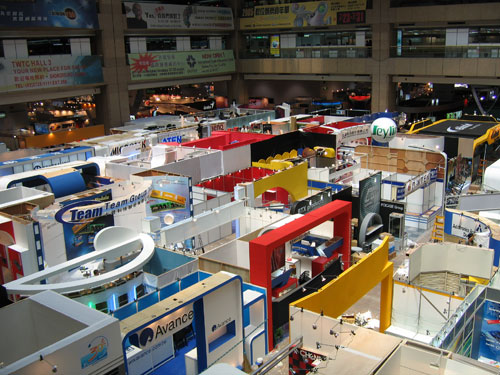
BTX Athlon 64 Motherboard
Intel's BTX standard continues to be fairly unsupported by the motherboard manufacturers we've met with. The motherboard and case manufacturers that we've met with have told us that by the end of this year BTX shipments will account for under 10% of their overall production. By the end of 2006, that figure is expected to rise to anywhere between 15 - 30%. If you're worried about the transition to BTX, you probably won't be forced to migrate until 2007 - 2008.
One concern we have all voiced is the lack of AMD motherboard designs for the BTX specification. Originally we worried that routing would be an issue thanks to the Athlon 64's on-die memory controller, but MSI put our fears to rest by bringing us the first Socket-939 BTX motherboard we've ever seen:
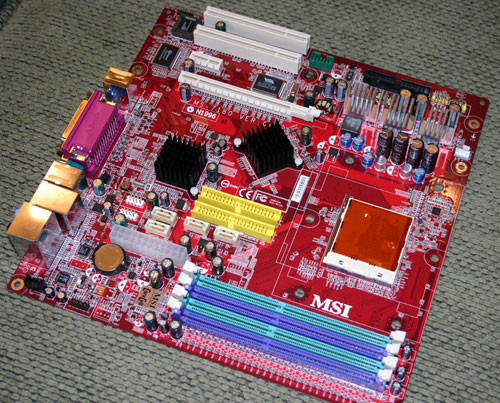
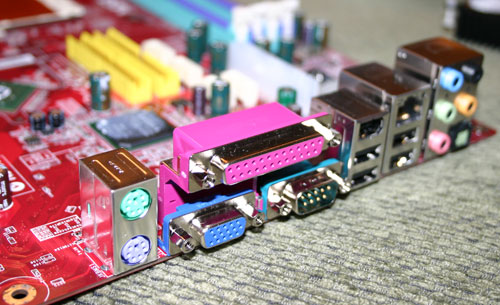
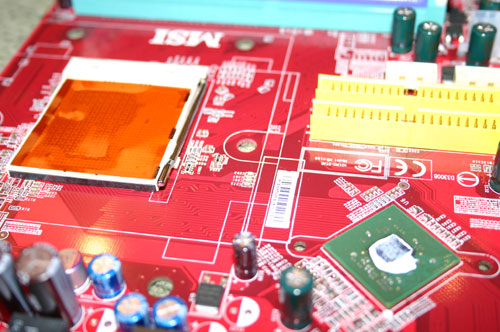
This particular board is based on NVIDIA's C51G integrated graphics chipset and adheres to the microBTX standard.
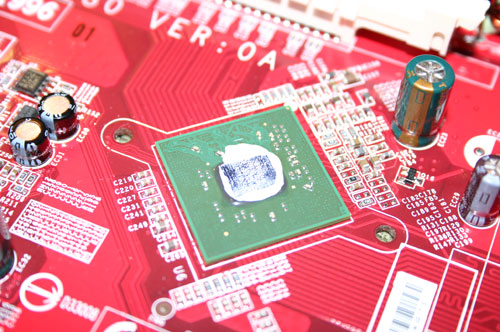
NVIDIA's C51G chipset - nForce4 + Integrated Graphics
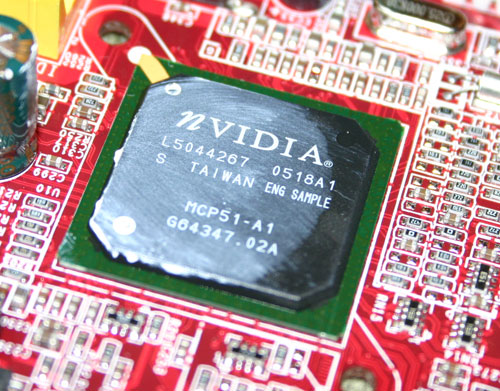
NVIDIA's C51G South Bridge, identical to what is on the nForce4 SLI Intel Edition
The board is due out for release by the end of this year, but it will be an OEM-only solution. MSI is demonstrating a total of two BTX motherboards at the show this year, which is a big increase from last year but in-line with the slow adoption rate we've seen for BTX.
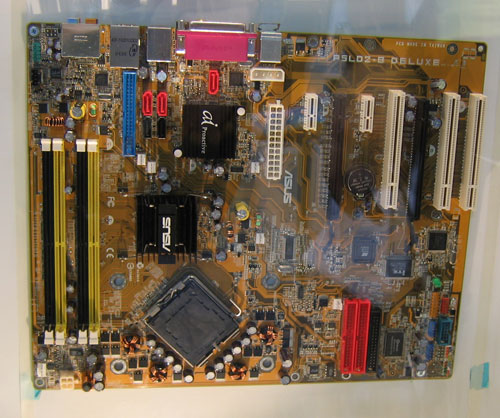
ASUS also had a few BTX motherboards at the show
The move to BTX is an expensive one for case manufacturers; the high costs of re-tooling and producing cases based on a new form factor have kept case manufacturers from embracing the new standard, especially given that ATX seems to be fulfilling users' needs just fine. The case manufacturers won't put much time and money behind BTX without widespread BTX motherboard availability, and motherboard manufacturers won't build BTX boards without widespread case availability. Like many new technologies in the PC industry, BTX presents both manufacturers with the classic chicken and egg scenario.










80 Comments
View All Comments
justly - Monday, May 30, 2005 - link
I never really understood the use of a riser card to make a motherboard compatibile with other processors. Well I guess it could be used by review sites to compare processors using the same platform, but other than that what reason would any sane person have for this feature?Anand, I am also curious as how you can still claim that Anandtech has no bias, yet in every Anandtech (or any other sites) articles featuring a SiS chipset, the SiS chipset allways seems to have good showing (please realize I'm talking chipsets not motherboards) yet tou make this comment.
"There are some limitations to the technology; first and foremost, you are stuck with SiS chipsets"
"STUCK WITH SIS CHIPSETS" doesn't that look like bias to you? If you really where unbiased I think you would have worded this differently.
Larso - Monday, May 30, 2005 - link
Very interesting that solid state. I wonder if you the standby 5V line from the powersupply would have enough juice to keep the memory alive?Adding a rechargeable battery seems like a rather expensive way to fix the problem... And using a programmable FPGA for controller? What is this, still a prototype??
mlittl3 - Monday, May 30, 2005 - link
Yes #20, #27 is right.Read the article a little closer. The PCI slot ONLY provides power. All transfers go through the SATA connector in the upper right of the PCB to your motherboard SATA connector. That will be 150MB/s. The PC recognizes the drive as a SATA drive on startup.
I wonder if they will come out with a SATA II 300MB/s version. That would rock even more. MORE DROOL!
MDme - Monday, May 30, 2005 - link
#20it is not limited by the PCI bus since the transfers actually occur over the SATA controller of the mobo.
i think though that it is just SATA 1 so that would limit it to 150mb/s (if it were SATA II then that would be 300mb/s.
Avalon - Monday, May 30, 2005 - link
That ECS board is very cool. I don't understand the hoopla over the solid state ram drives, though.Dubb - Monday, May 30, 2005 - link
I wonder if you could setup one of those cards as a second OS installation, and have it sync'ed with one on a HD - point being that you could boot to the HD if the ramdrive wasn't available/wiped after 16 hours.I'm going to have to wait for reviews + stories of people using the card, but I very well could end up using 2-3 of these things depending on how well they work. the productivity increase would probably be worth whatever they cost.
DDR max? can you even buy that anymore? what about 2gb modules? hmmm.
Brian23 - Monday, May 30, 2005 - link
I will be the first one to own one of these ram-drive cards.Googer - Monday, May 30, 2005 - link
I love the concept here, but for the amount of money that I would end up spending here I would rather have a couple of 74gb SCSI drives.The one advantage that this card has over installing extra ram on your system is that data stored on this card is bootable and does not have to be dependant on a HDD. Where as adding ram to your PC the data will be gone as soon as you shut down your PC. Also Windows does not treat ram the same way it treats a HDD, but I know there is software that can take care of that.
semo - Monday, May 30, 2005 - link
goddamn #21 and all the rest. stop it. i'm running out of drool heredavecason - Monday, May 30, 2005 - link
#17 has a good point, you can use a solid-state drive for all kinds of things. In addition to a great swap file:1. Website Hosting: You could store your websites on the fast solid-state disk to improve delivery performance.
2. Database: You could put your database files (logs or data) on the solid state disk to improve request times. You could probably even use a file-based database like Access or FoxPro with some efficiency.
3. Video editing: half the time you spend doing this work is waiting for data to be read from or written back to the hard drive.
4. Dumb Terminals: you could set up a simple BART PE boot image on the solid-state disk to allow a client workstation to boot quickly and access a mainframe, web application, or Terminal Server. They would be expensive but fast. Any data loss could be recovered by simply booting to a CD to reinitialize the drive from the CD's contents.
5. If you had a good backup process, you could put your system boot files on it. Imagine how fast you could hibernate your computer to and from one of these solid-state devices.
You could even make a RAID1 or RAID5 mirror out of these things for some redundancy if you had enough slots and cash.